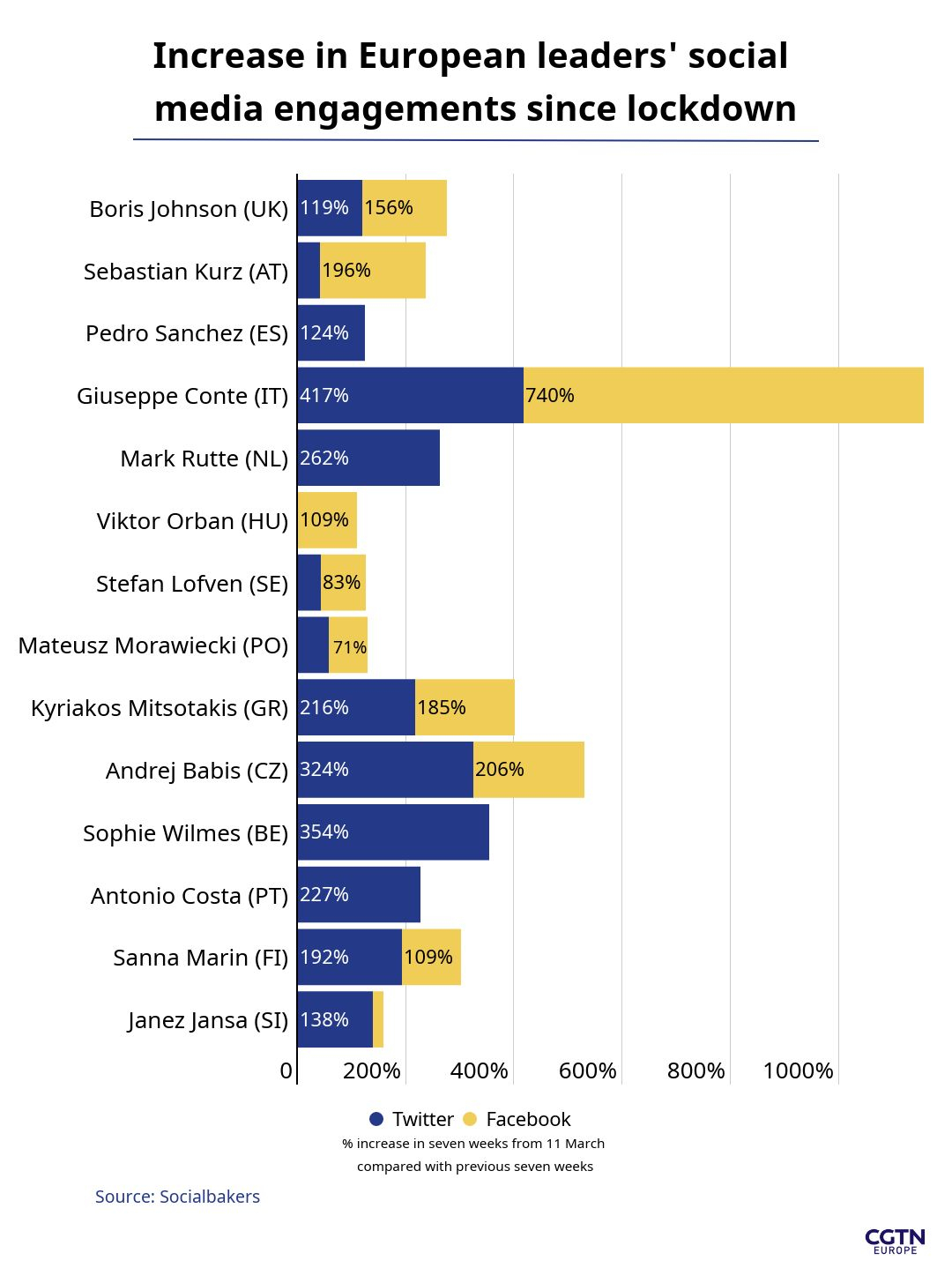In the weeks since countries in Europe were placed under lockdown to stop the spread of COVID-19, millions of homebound Europeans have been taking to social media – and they seem to be interacting more with their political leaders.
For many, the reality is that social media has become a near-essential resource. Whether for updates on the latest COVID-19 news in their country, or to stay in touch with friends and relatives and share experiences, or just for some comic relief and idle scrolling to pass time, users have been turning to their Twitter, Facebook and Instagram feeds.
According to data published by Statista, global social media use increased by 21 percent during the period from the middle to the end of March, when many countries in Europe first began their nationwide measures to restrict movement.
While news updates have been one of the main reasons for increased social media activity, users have also been interacting more with their political leaders on sites including Facebook and Twitter, as they search for direction during the crisis.
European leaders have gained a significant increase in engagement on Twitter and Facebook since 11 March, when Italy became the first in Europe to go into lockdown, according to data collected by social media marketing company, Socialbakers.
Engagement means how users have interacted with these leaders, including liking, sharing and commenting on Facebook posts, or retweeting and replying to Tweets.
These data were collated to show the percentage increase from 11 March to 29 April compared with the previous seven-week period from 21 January to 10 March.
So, which European leaders performed best?

Well, the clear winner by far is Italy's prime minister, Giuseppe Conte, whose combined Twitter and Facebook engagement went through the roof with an increase of more than 1,100 percent.
Conte's Facebook page, which had more than 3.1 million likes and almost four million follows, showed the greatest amount of interaction, with a 740 percent increase. His Twitter page had a significantly smaller following, with just over 640,000 followers but, nevertheless, interaction with his profile increased a huge 417 percent.
While the figures don't show whether the interactions were positive or negative, the increase could be tied to the surge in popularity for Conte in the country. A poll by Italy's Demos & Pi showed a surge in Conte's approval ratings to 71 percent, while approval for the health system's reaction to the virus stood at a high 94 percent.
On the other end of the spectrum, with the smallest increase in engagement, is Sweden's prime minister, Stefan Löfven. Löfven's Twitter profile, which had 74.8K followers, received a small increase of 42 percent in engagement, while interactions with his Facebook page of fewer than 170,000 likes and follows didn't fare much better, with an 83 percent increase.
One explanation for this low increase change since lockdown measures were introduced could be due to the fact that, unlike other countries in Europe, Sweden didn't implement stringent lockdown measures, choosing instead to take a softer approach.
While their counterparts across the continent were limited to very minimal-to-no movement, Swedish citizens were free to continue their daily activities, albeit while taking precautions and following some minimal government guidelines.
Other leaders receiving a relatively low increase in engagement with their social media pages are Hungary's Viktor Orbán, Spain's Pedro Sánchez, Poland's Mateusz Morawiecki and Slovenia's newcomer Janez Janša.
While many would have expected Slovenia's prime minister, Janez Janša, to perform better, given that he had just taken office on 13 March and should have gained more engagement, this is not the case.
Though Janša's relatively small following on both Twitter (63,100) and Facebook (40,300) could be part of the reason for the low increase in engagement, other factors could be at play. Slovenia has been one of the least-affected countries in Europe by the coronavirus, with infections currently standing at 1,460, and deaths just passing the 100 mark. Strict lockdown measures implemented in the country since the middle of March have been slowly easing since 20 April, earlier than many.
As a general rule, it seems – though there are outliers – the more populist the leader, the fewer engagements with their social media accounts, or agreement with the country's stance on tackling the coronavirus. This may explain the low engagement increase for Poland’s prime minister, Mateusz Morawiecki, as well as Hungary's prime minister, Victor Orbán, who has been criticized by some for using the pandemic to gain sweeping powers and rule by decree without a set time limit.
As for the rest of Europe, most of the other leaders have gained an increase in engagement of more than 200 percent.
Belgium's prime minister, Sophie Wilmès, had the highest increase in engagement on Twitter after Conte with a 354 percent rise in interaction from her 44.8 thousand followers, since lockdown measures began. This Twitter engagement increase was closely followed by the prime minister of the Netherlands Mark Rutte with a 262 percent increase, Portugal's António Costa with a 227 percent increase, and Greece's prime minister, Kyriakos Mitsotakis, with a 216 percent increase.
Finland's prime minister Sanna Marin, Britain's prime minister, Boris Johnson, and Austria's Sebastian Kurz all fared fairly the same with an increase in engagement on both Facebook and Twitter combined around the 200 to 300 percent mark.
Czechia's prime minister, Andrej Babiš, had the second highest increase in combined Twitter and Facebook engagement, at 530 percent, trailing Italy's Conte.